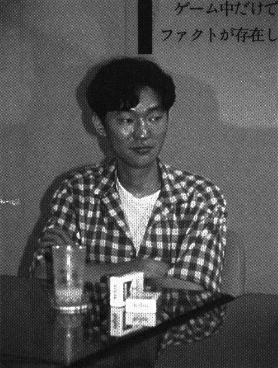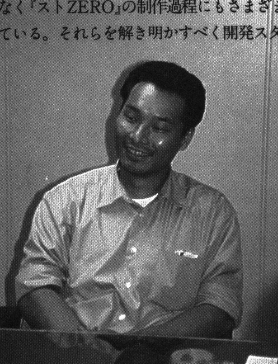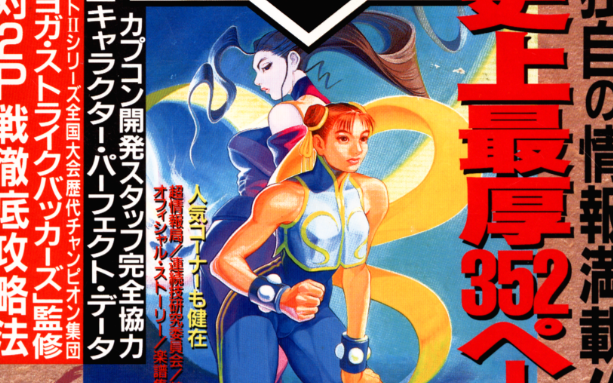Published in All About Series Vol. 11 – Street Fighter Alpha (October 25, 1995). Interview with several Capcom staff members about the recently released Street Fighter Alpha/Zero.
“Street Fighter Alpha is an experimental title, in a way”
Even outside the contents of the game itself, many mysterious facts surround the development process of Street Fighter Alpha. We engage the development staff to explain.

Noritaka Funamizu
Assistant director of Capcom AM development division. Producer of Street Fighter Alpha. Had a hand in the development of SFII Turbo, Super SFII, and Super Turbo.

Seiji Okada
Assistant manager of Capcom AM software development section. Programmer responsible for Ryu and Ken in the original Street Fighter II. Also worked on the SNES versions of Street Fighter II and Turbo.

Haruo Murata
Senior manager of Capcom AM software planning section. In charge of all planning and writing for Street Fighter II, Super Turbo, and now Alpha.
Street Fighter reborn
– This is a bit of a rote question to start, but what does the “Zero” in the game’s Japanese title, “Street Fighter Zero”, mean?
Funamizu: The main meaning behind it is “origin”. Murata and I have been working on the Street Fighter series for a while, and we figured Super Turbo would be the last one. But it’s a popular series, so of course we ended up making another one anyways. Rather than continuing to drag out Street Fighter II, we thought we’d try making our own brand new Street Fighter.
– Around when did the development of the game begin?
Funamizu: It started October of last year, over 6 months after Super Turbo was finished. We were working on Vampire Hunter/Night Warriors, thinking that we were totally done with Street Fighter II at that point. But then once Vampire Hunter was finished, we suddenly had the plan for Street Fighter Alpha squirm its way onto our schedules. So, we ended up doing it.
– What were the key concepts you had in mind for a new Street Fighter?
Funamizu: First and foremost was character popularity. One of the major concepts behind the game was building popularity for Street Fighter’s characters. Any way you look at it, Capcom’s library up until now has a lot of understated games. Out of all those, Vampire Hunter’s characters are insanely popular. When I saw the kind of enthusiasm that only Vampire Hunter was getting, I wanted to try pursuing that direction.
– I see.
Funamizu: Also, Capcom’s games seem to be getting grander in scale. Vampire Hunter took around two years, and was a massive pain. The drive for more ambitious games is absolutely going to continue being one of Capcom’s pillars, but sometimes, I figure it’s okay to make something a bit different too.
– Something different?
Funamizu: Yeah. If we only had 10 months, we wanted to challenge ourselves and see just how much we could pack into a game with a 10 month development period. If we could do that, we’d be able to provide an even greater number of fun games to users. So in that sense, you could say Street Fighter Alpha is something of an experimental title for Capcom. Now that I think about it, the fact that we’re using the Street Fighter series to try this out is kinda crazy (laughs). As a matter of fact, if we were to compare the sizes of the data, Street Fighter Alpha is only about a quarter this size of Vampire Hunter. But it got an even better response than I had expected, so I was relieved.
About the characters
– How did you go about picking characters for the game’s roster?
Funamizu: For starters, we knew we had to keep Ryu, Ken, and Chun-Li, and then we decided the rest from there. The first thing we paid attention to was the background of the characters. We didn’t want to end up with just Japanese and Asian characters. As much as we could, we wanted to think in terms of creating a good balance, with all sorts of different skin colors.
Murata: We also chose some characters based on elements relating to game balance, such as body size or agility.
Funamizu: We didn’t want to just lean on Street Fighter II either, we wanted to bring out the full spectrum of Street Fighter. So we brought in characters from the original Street Fighter, and because Final Fight’s working title was “Street Fighter ’89”, that means it’s also part of the series (laughs), so we brought characters from there too.
– Did you plan on including brand new characters from the start?
Funamizu: We did. We called them “New Character 1” and “New Character 2” the whole time (laughs).
– And in the end, those two became Charlie and Rose.
Funamizu: There’s right. Among fighting game players, there’s two camps: motion players and charge players. When it comes down to it, there’s more people who like playing motion characters, but I believe that charge characters have their own unique kind of fun to them. So we added Charlie in hopes that people could understand it.
– In Street Fighter II, Charlie is mentioned as being Guile’s war buddy, but there’s no official comment on whether the Charlie in Street Fighter Alpha is the same person. When exactly should we think of Street Fighter Alpha as taking place?
Murata: We were going for several months or so after Street Fighter I. Something like, Ryu defeats Sagat, then several months pass.
– So, it is in the same timeline as Street Fighter I and II, then.
Murata: For better or for worse… In some ways, this game contradicts the canon established by Street Fighter II. I think people should play it with the mindset of “perhaps this fight was mentioned somewhere in Street Fighter II”. So, not every ending necessarily ties in perfectly with other games in the series… But somehow or another, we want people to imagine this as being what happened after Street Fighter I.
– I hear lots of theories about it being an alternate universe.
Murata: One of the main concepts behind Street Fighter Alpha is letting players user their imagination freely to create the world of Street Fighter for themselves, and that we wouldn’t be too pushy about an official canon. So in that sense, you could say there’s as many alternate universes as there are players.

The story behind Ryu & Ken vs. Bison mode
– Something that surprised me about this game is just how many secrets there are. When I played Vampire Hunter, I thought “it sure seems like Capcom has cut down on the number of complex commands and hidden mechanics”, and then…
Funamizu: When it comes to secrets, using Akuma in Super Turbo was something that really surprised people. If that much was able to surprise people, we figured we could do it again here. But this time, we used the “?” select to make people aware of Akuma and Bison from the start, while with Dan, we expected that in some way or another, he would get spoiled immediately. The true secret of Street Fighter Alpha is the Ryu & Ken vs. Bison 2v1 mode, where if word didn’t get out, we figured we would just stay silent. But lots of people have already spoiled it (laughs).
– Was that 2v1 battle mode part of the plan from the start?
Funamizu: No, no. In the middle of development I said “it would be pretty fun if we could do something like this” without even thinking about it. Then Okada was like “sounds good, let’s do it”.
Okada: Though I regretted saying that (laughs).
– Was that tough from a programming perspective?
Okada: If we had planned on doing it from the start, it wouldn’t have been too bad. But because it was added in later, there ended up being a lot of problems, and it was a huge pain.
– Did you plan on having characters other than Ryu and Ken be playable in that mode?
Funamizu: We did not. If we didn’t put certain restrictions on it from the start, it would’ve gotten out of hand. When the playable characters are Ryu and Ken, you have two distinct clothing colors: white and red – this was one of the main conditions for the mode.
– If we’re talking about that mode, we have to bring up what sounds like Ryoko Shinohara’s music in the background…
Funamizu: Since the theme from the Street Fighter II anime became such a big hit, we starting having tantrums in the office about how we just had to include it, but the higher-ups objected. The copyright fee is 10 yen per one minute of song. I say it’s just 10 yen, but we would need to pay that share however many thousand times. In the end, we were able to include it in just the Japanese version, and the staff was really excited about it. The sound department were like “let’s do it, let’s do it”, and ended up making it before we even got the OK (laughs). At the time, the song was 2 minutes and 3 seconds, so some people figured we could just trim it by 3 seconds so we’d only need to pay 20 yen. But the voices saying “well, we might as well make it a bit longer and just pay 30 yen” won out, and it ended up being a pretty long song.
Dan’s true character
– When we’re talking about secrets, I have to ask about Dan…
Funamizu: Our guy Yasuda, who’s been working on designs for us since Final Fight, made some art for a CD booklet back in the day in which Sagat was holding this martial artist up by the head. People said that the KO’d martial artist looked like Ro██rt Sa██za██, and I think Dan was also born from that kind of playfulness. I don’t know if it’s true, but there’s talk that when a certain other company saw Dan, they said “we’ll get you back for this!” (laughs).
– Is there any particular significance to Dan being unusually weak?
Funamizu: Everyone is suspicious of us making some kind of statement with that, but it was actually decided on before Dan ended up becoming the character he is now. The martial artists you see in games are pretty crazy, right? Like, you only see martial artists who are way beyond what you would see at, say, the K-1 Grand Prix. So we figured that if we added someone who wasn’t like that, who was just a normal martial artist, it would highlight just how incredible they are. In other words, we wanted to try adding a character with the concept of “a second-rate martial artist”.

What’s a “○○○○○○ Punch”?
– What kind of special moves didn’t make the final cut?
Funamizu: Too many to name, but my masterpiece is “○○○○○○”. It was a special move were Sodom would do an impression of ××××× and jump. The name of the move was “○○○○○○ Punch”, and it had a sound effect and everything (laughs). We also had an idea where if you would jump over a barrel that rolls towards you, you would get 3000 points (laughs).
[Elsewhere in the book, it’s revealed that the name of the move was “Mintendo Punch”. And of course, the character Sodom would mimic was Mario.]
– Why was it scrapped?
Funamizu: It gave off the wrong vibe. I’ve always thought of Final Fight’s Sodom as being an extremely cool character. On the other hand, in Street Fighter Alpha, as soon as he took out the jitte, he was on the road to becoming a joke character. The designers kept making humorous entrance animations for him, and it just went off the rails.
– Were there any ideas for game mechanics that didn’t end up getting used?
Funamizu: Rolling wakeups. They were in there at one point, but at location testing, we get a lot of opinions from players saying “I can’t do the wakeup game I developed in Street Fighter II, please fix it”. But we thought it would be good to have something to get people on the offensive, so we changed it to the recovery rolls you see in the final game.
Murata: The Super Combo Gauge also saw some major changes. At first, you wouldn’t be able to use any Super Combo you wanted like you could now. For instance, Shinku Hadouken would use 1 gauge, Shinku Tatsumaki Senpukyaku would use 2 gauges… the amount of meter they would use was preset.
Funamizu: But when people started talking about how it was a bit hard to understand and probably not a good idea, Murata submitted a timely new plan, and that’s what we went with. So, he sorta made us totally change it (laughs).
Okada: There’s no “sorta” about it, it was exhausting. We had to basically redo the whole thing.

Why was Street Fighter II a hit?
– By the way, the feel of Street Fighter II, or how the characters on the screen react to your inputs, is superb. I consider that to be the reason Street Fighter II is a top-class 2D fighting game. Is there some kind of secret to it?
Okada: The main programmer on the original version of Street Fighter II was abnormally fixated on that part of the game. To give just one example, there’s programming in the game so that if you input both an attack and a guard at the same time, the computer will figure out which one to do based on the current state of the game. That user-friendliness you feel when you’re playing the game is a result of that programmer’s dedicated efforts.
Funamizu: As I mentioned before, Street Fighter Alpha had a very short development period, but that policy of addressing the finer points of the game with care still carried over. For even just one normal, we’ll consider what purpose it serves, all the way back to the thinking that led to Street Fighter having 6 buttons in the first place. We approached it with complete thoroughness. We call that “game-y-ness”, and I think it can be found in every part of the game. The act of pressing one button, or moving the stick, or even looking at the screen are all examples of that “game-y-ness”. I firmly believe that a title that has completely processed these elements one at a time is sure to become a hit. That’s the part of the game you’re particular about. And I think the number of people who care about that part of games has been increasing, and all kinds of great titles have been showing up.
– Street Fighter II and its successors are what really kicked off the fighting game boom. Why do its developers think it caught on quite so much?
Funamizu: That’s a tough one (laughs). Around here we use the term “throwdown tool” a lot, and I think people got hooked on it in that sense, as a means of going head-to-head with people. After that, countless other fighting games started releasing, but I think the fact that a lot of people still stuck with Street Fighter II is evidence of how well-made the original mechanics were. You could say it’s a “throwdown tool” where the more you play it, the more you get out of it. I think that’s the #1 reason.
#2 would be the proliferation of head-to-head arcade setups, I think that’s been a big influence. That’s all thanks to the hard work of arcade operators.
– The makes sense, I don’t think the fighting game boom would’ve gotten quite so big without those head-to-head dual-cab setups.
Funamizu: I was surprised when I first saw it. Like, “what are you doing? If you do that, won’t the colors on one side be off?” (laughs). But they even sell harnesses just for that.
Okada: I wonder who even came up with that. What a great idea.
– Whoever it is has done a real unrecognized service to the game industry.
Funamizu: I’d like to give him an award or something (laughs).

Street Fighter Alpha’s sequel will be released!!
– After doing Super Turbo, instead of moving on to III, you went back to Zero. Why’s that?
Funamizu: Please don’t ask me something you know I’ll have trouble answering (laughs). It’s because III is something else being worked on.
– What!? Really?
Funamizu: More accurately, it’s not III, but we’re working on something like a III. Something else.
– Is it a polygonal Street Fighter II?
Funamizu: Ah, that’s what the rumor is, but that’s not it. Well, let’s just call it the ultimate fighting game. But I can’t say much about that yet, that’s talk for next year and beyond.
– Are there any plans for a sequel to Alpha?
Funamizu: We’re working on that too.
– What!?
Funamizu: We don’t know when it will be out yet, though.
– Is the title gonna be something like “Alpha II” (laughs).
Funamizu: We haven’t decided that yet. Just let the All About readers know that a sequel to Street Fighter Alpha is being worked on. Please look forward to seeing what kind of game it ends up being.
– As is the custom, any last messages for the All About readers?
Murata: I hope the players can help build the world of Street Fighter Alpha. Please write lots of comics and stories.
Okada: When they guard, Shoryuken (laughs)! Sorry for debugging.
Funamizu: We made Street Fighter Alpha to be a game that all kinds of people can enjoy, so even if someone has stopped playing fighting games, I hope they try one more time with this one. I plan to keep making games you can enjoy with lots of other people, so please look forward to it.
(8/17/1995, at Capcom’s development building)
